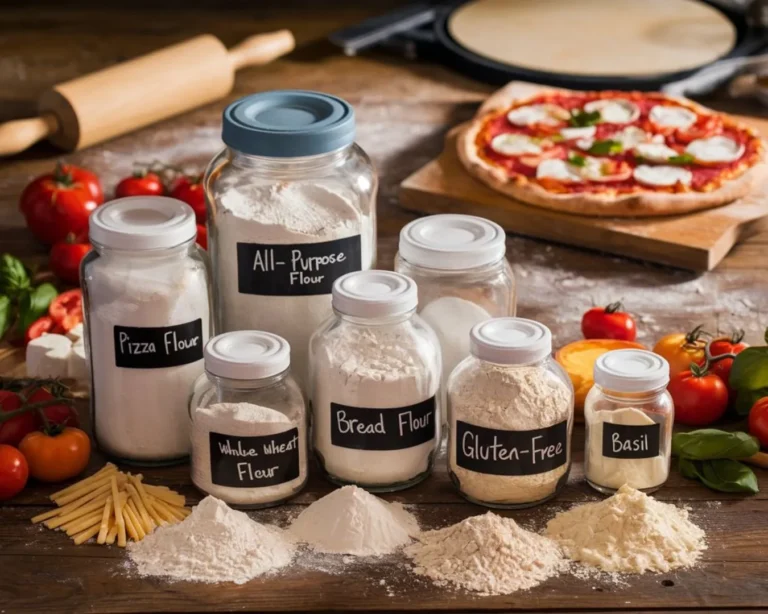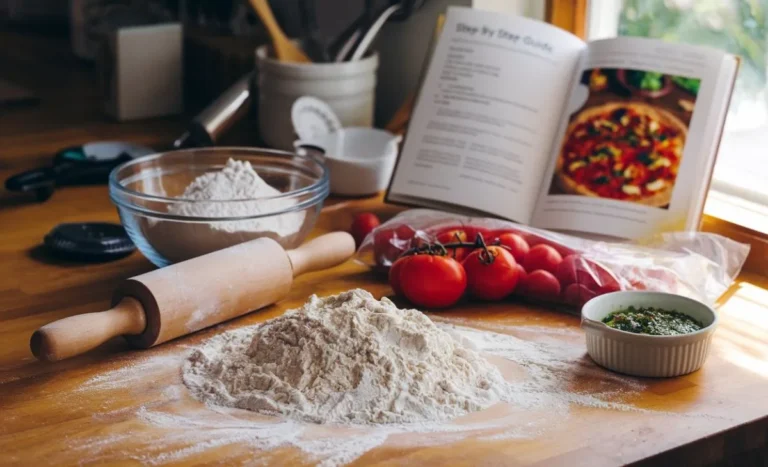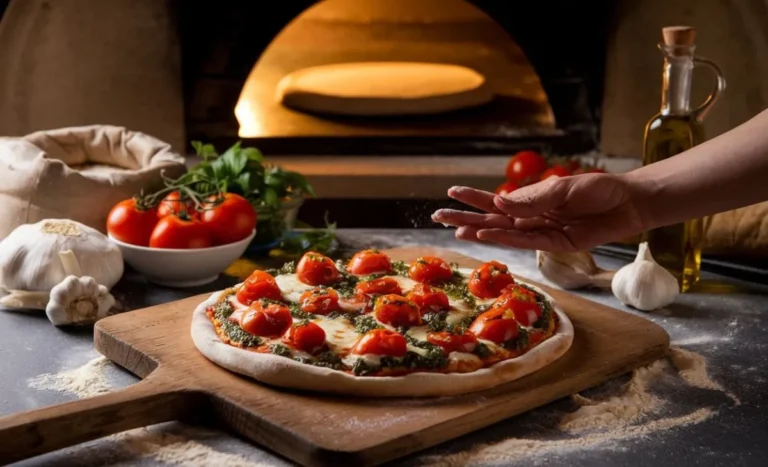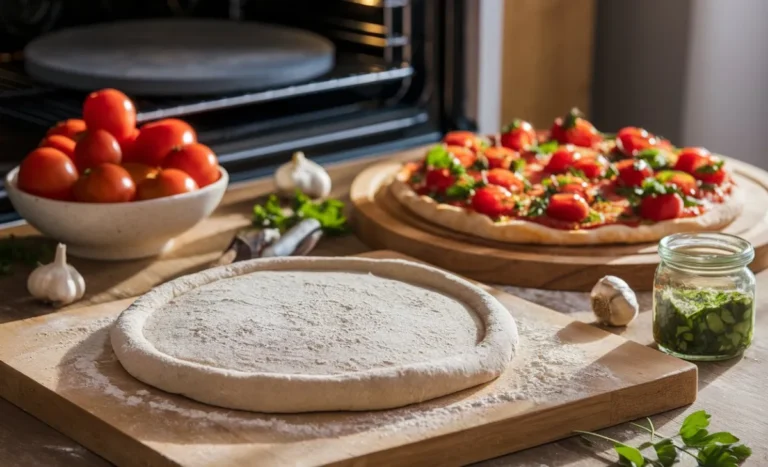The Ultimate Guide to Choosing the Best Pizza Flour for Perfect Crusts
Introduction to Pizza Flour
When it comes to creating the perfect pizza, the choice of pizza flour is crucial. The type of flour you use can significantly impact the texture and flavor of your crust. With a variety of options available, understanding the differences can be overwhelming. However, knowing the right flour to choose will elevate your pizza-making skills and lead to delicious results.
Pizza flour is typically high in protein, which contributes to the dough’s elasticity and chewiness. This quality is essential for achieving that coveted pizzeria-style crust. While many home cooks opt for all-purpose flour, specialty flours can offer unique benefits. For instance, Italian 00 flour is renowned for its fine texture and high gluten content, making it ideal for Neapolitan-style pizzas.
Additionally, different types of pizza flour can create varying flavor profiles and crust textures. Whole wheat flour, for example, adds a nuttier taste, while semolina flour can enhance the dough’s structure. Therefore, experimenting with different flours can lead to exciting culinary adventures. As you learn more about pizza flour, you’ll discover the perfect blend to match your personal preferences.
In conclusion, selecting the right pizza flour is the foundation for a perfect crust. With this knowledge, you can confidently explore various flours and create pizzas that impress your family and friends. As you read further in this guide, you will gain insights into the best pizza flour options, ensuring your homemade pizzas are always a hit.
Understanding Flour Types: All-Purpose vs. Specialty
Choosing the right type of pizza flour is essential for crafting the perfect crust. While all-purpose flour is a common choice for many home cooks, specialty flours can enhance your pizza-making experience. Understanding the differences between these flours will help you select the best option for your culinary creations. In this section, we’ll explore all-purpose flour and specialty flours, their unique characteristics, and how they contribute to your pizza dough.
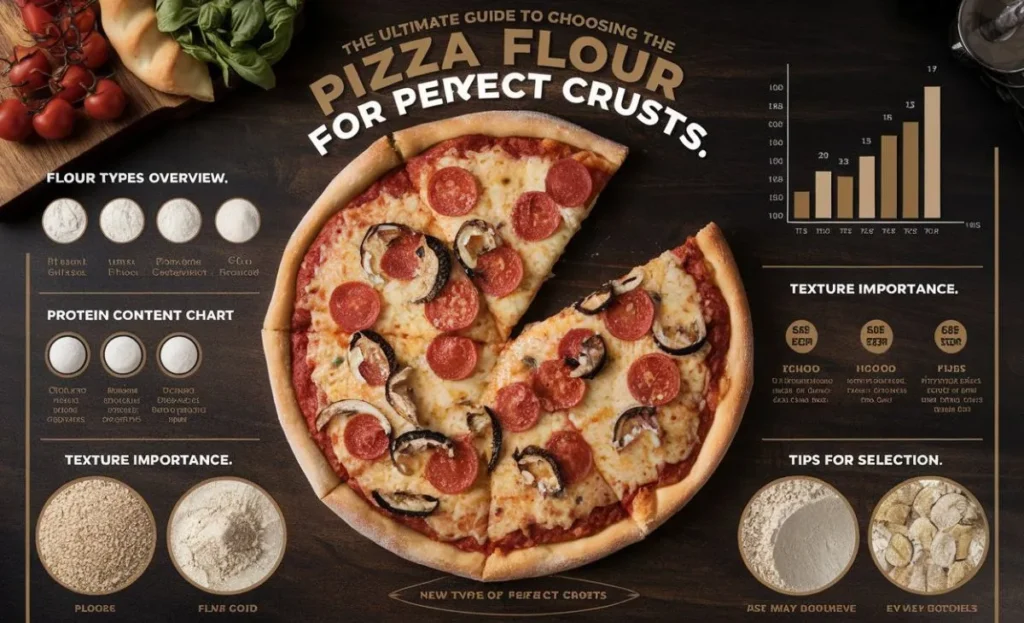
All-Purpose Flour
Ingredients:
- 4 cups all-purpose flour
- 1 ½ cups warm water
- 2 ¼ teaspoons active dry yeast (1 packet)
- 2 tablespoons olive oil
- 1 teaspoon sugar
- 2 teaspoons salt
Step-by-Step Cooking Instructions:
- Activate the Yeast: In a small bowl, combine warm water, sugar, and yeast. Let it sit for about 5-10 minutes until it becomes frothy.
- Mix Ingredients: In a large mixing bowl, combine the all-purpose flour and salt. Create a well in the center, then add the activated yeast mixture and olive oil.
- Knead the Dough: Mix the ingredients until a dough forms. Transfer it to a floured surface and knead for about 8-10 minutes until smooth and elastic.
- First Rise: Place the dough in a lightly greased bowl, cover it with a clean cloth, and let it rise in a warm place for about 1 hour or until doubled in size.
- Shape and Bake: Preheat your oven to 475°F (245°C). Punch down the risen dough, shape it into a pizza, and add your favorite toppings. Bake for 12-15 minutes or until the crust is golden brown.
All-purpose flour is versatile and easily accessible, making it a popular choice for many recipes. However, while it works well for various pizza styles, its lower protein content (about 10-12%) may not provide the chewy texture desired in traditional pizza.
Specialty Flours
Ingredients:
- 4 cups Italian 00 flour (or your chosen specialty flour)
- 1 ½ cups warm water
- 2 ¼ teaspoons active dry yeast
- 2 tablespoons olive oil
- 1 teaspoon sugar
- 2 teaspoons salt
Step-by-Step Cooking Instructions:
- Activate the Yeast: Just like with all-purpose flour, begin by activating the yeast in warm water with sugar. Allow it to froth for about 5-10 minutes.
- Combine Ingredients: In a large bowl, mix the Italian 00 flour with salt. Create a well in the center and pour in the activated yeast mixture along with olive oil.
- Knead the Dough: Combine the ingredients until a dough forms. Knead on a floured surface for 8-10 minutes until the dough is smooth and elastic.
- First Rise: Place the dough in a greased bowl, cover it, and let it rise for 1 hour in a warm location.
- Shape and Bake: Preheat your oven to 475°F (245°C). Once the dough has risen, punch it down, shape it, and add toppings. Bake for 12-15 minutes until the crust is golden and crispy.
Specialty flours like Italian 00 flour have a higher protein content (around 12-14%) and a finer texture. This flour is ideal for Neapolitan-style pizzas, creating a lighter, chewier crust that many pizza enthusiasts crave.
Conclusion
In summary, understanding the differences between all-purpose and specialty flours is vital for achieving the perfect pizza crust. By experimenting with these flours and following the cooking instructions provided, you can elevate your homemade pizzas to a new level. Whether you prefer the convenience of all-purpose flour or the quality of specialty flours, each option offers unique benefits that can enhance your pizza-making experience. So, gather your ingredients and start exploring the world of pizza flour today!
Key Characteristics of High-Quality Pizza Flour
Choosing the right pizza flour can make or break your homemade pizza experience. High-quality pizza flour plays a crucial role in achieving the perfect crust, providing the ideal texture and flavor. In this section, we will explore the key characteristics of high-quality pizza flour and why they matter. Understanding these traits will empower you to make informed choices when selecting the best flour for your pizza-making endeavors.

Key Characteristics
- Protein Content: The protein content in pizza flour is one of the most critical factors influencing the dough’s structure. High-quality pizza flour typically has a protein content of 12-14%, which promotes gluten development. Gluten is essential for creating the chewy, elastic texture that pizza lovers adore.
- Absorption Rate: The ability of flour to absorb water is vital for achieving the desired dough consistency. High-quality pizza flour should have an excellent absorption rate, allowing you to create a dough that is neither too sticky nor too dry. This balance is crucial for optimal fermentation and dough handling.
- Texture: The texture of pizza flour can vary significantly. Fine-textured flours, like Italian 00 flour, result in a softer dough, while coarser flours can yield a more robust crust. High-quality flour should feel smooth to the touch, indicating its refinement and suitability for pizza-making.
- Flavor Profile: The flavor of pizza flour can influence the overall taste of your crust. High-quality flours often have a mild, slightly nutty flavor, enhancing the pizza without overpowering other ingredients. Freshly milled flour can also provide a more complex taste.
- Freshness: Freshness is key when it comes to flour. High-quality pizza flour should be stored properly to maintain its freshness, ensuring that you achieve the best flavor and performance. Look for flour with a recent milling date for optimal results.
Step-by-Step Cooking Instructions for High-Quality Pizza Dough
Ingredients:
- 4 cups high-quality pizza flour (such as Italian 00 flour)
- 1 ½ cups warm water (110°F or 43°C)
- 2 ¼ teaspoons active dry yeast (1 packet)
- 2 tablespoons olive oil
- 1 teaspoon sugar
- 2 teaspoons salt
Step-by-Step Instructions:
- Activate the Yeast: In a small bowl, combine warm water and sugar, then sprinkle the yeast on top. Let it sit for 5-10 minutes until it becomes frothy.
- Mix Ingredients: In a large mixing bowl, combine the high-quality pizza flour and salt. Create a well in the center, then add the activated yeast mixture and olive oil.
- Knead the Dough: Stir the ingredients until a rough dough forms. Transfer it to a floured surface and knead for about 8-10 minutes until the dough is smooth and elastic.
- First Rise: Place the dough in a lightly greased bowl, cover it with a clean cloth, and let it rise in a warm place for about 1 hour, or until doubled in size.
- Shape and Bake: Preheat your oven to 475°F (245°C). Once the dough has risen, punch it down, shape it into a pizza, and add your favorite toppings. Bake for 12-15 minutes or until the crust is golden brown.
Conclusion
In conclusion, understanding the key characteristics of high-quality pizza flour is essential for crafting the perfect crust. By selecting flour with the right protein content, absorption rate, texture, flavor profile, and freshness, you can elevate your homemade pizzas to new heights. Armed with this knowledge and the step-by-step instructions provided, you’re ready to create pizzas that will impress your family and friends. So, gather your ingredients and enjoy the delicious journey of pizza-making!
Gluten Content and Its Impact on Crust Texture
When it comes to making delicious pizza, understanding the role of gluten in your pizza flour is essential for achieving the ideal crust texture. Gluten is a protein found in wheat that provides elasticity and strength to dough. The amount of gluten in your flour directly influences the chewiness, crispiness, and overall texture of your pizza crust. In this section, we will delve into the significance of gluten content in pizza flour and how it affects your crust, helping you make the best choices for your homemade pizzas.
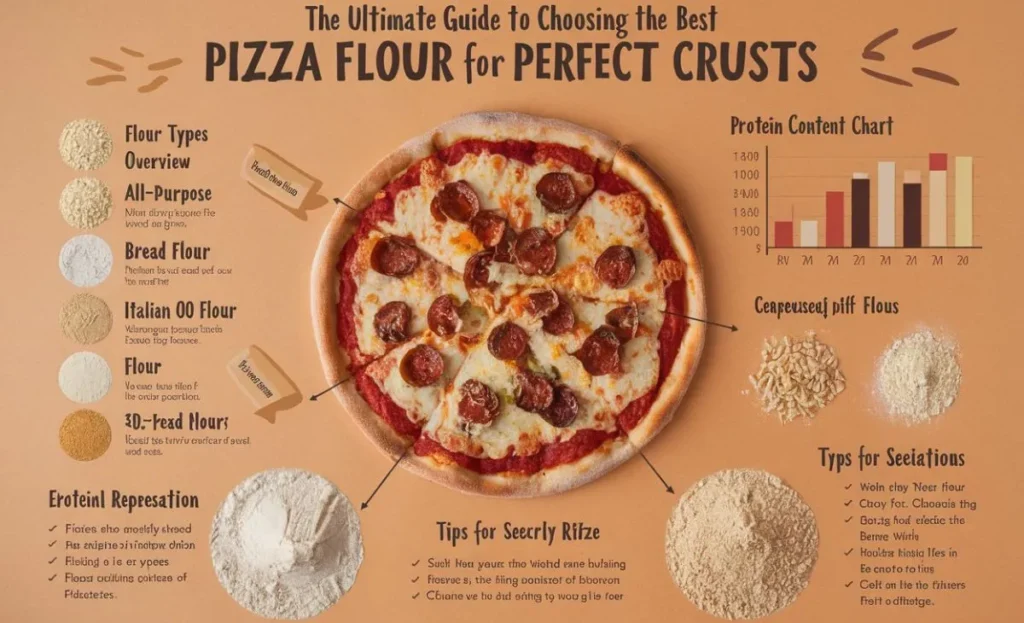
The Role of Gluten in Pizza Dough
Gluten forms when flour is mixed with water and kneaded. This process creates a network of proteins that traps air, allowing the dough to rise. High gluten content—typically found in specialty pizza flours—yields a chewier, more elastic dough that can hold up to various toppings. Conversely, low gluten flour results in a tender, crumbly crust. For those seeking the perfect pizza crust, selecting a flour with the right gluten content is vital.
Step-by-Step Cooking Instructions for a Chewy Pizza Crust
Ingredients:
- 4 cups high-gluten pizza flour (such as bread flour or Italian 00 flour)
- 1 ½ cups warm water (110°F or 43°C)
- 2 ¼ teaspoons active dry yeast (1 packet)
- 2 tablespoons olive oil
- 1 teaspoon sugar
- 2 teaspoons salt
Step-by-Step Instructions:
- Activate the Yeast: In a small bowl, combine warm water and sugar. Sprinkle the yeast over the water and let it sit for about 5-10 minutes, until frothy.
- Combine Ingredients: In a large mixing bowl, mix the high-gluten pizza flour and salt. Create a well in the center, then pour in the activated yeast mixture and olive oil.
- Knead the Dough: Stir the mixture until a rough dough forms. Transfer it to a floured surface and knead for about 8-10 minutes, until the dough is smooth and elastic. This step is crucial for developing gluten.
- First Rise: Place the dough in a lightly greased bowl and cover it with a clean cloth. Let it rise in a warm place for about 1 hour or until it doubles in size.
- Shape and Bake: Preheat your oven to 475°F (245°C). Once the dough has risen, punch it down and shape it into a pizza. Add your favorite toppings and bake for 12-15 minutes, or until the crust is golden brown and crispy.
Conclusion
In conclusion, gluten content in pizza flour significantly impacts your crust texture. By understanding how gluten works and selecting the right flour, you can create the perfect pizza crust tailored to your taste preferences. With high-gluten pizza flour, you can achieve a chewy, satisfying texture that holds up to toppings and delivers a delightful pizza experience. Now that you have the knowledge and the recipe, it’s time to roll up your sleeves and enjoy making pizzas that impress!
Regional Flours: Exploring Italian 00 Flour and Beyond
When it comes to pizza flour, the choice of flour can dramatically affect the outcome of your crust. Among the many types available, regional flours hold a special place, each offering unique characteristics that enhance your pizza-making experience. Italian 00 flour is perhaps the most renowned, celebrated for its fine texture and high protein content, ideal for achieving that coveted Neapolitan-style crust. In this section, we’ll explore Italian 00 flour and other regional options, helping you understand their unique qualities and how to incorporate them into your pizza recipes.
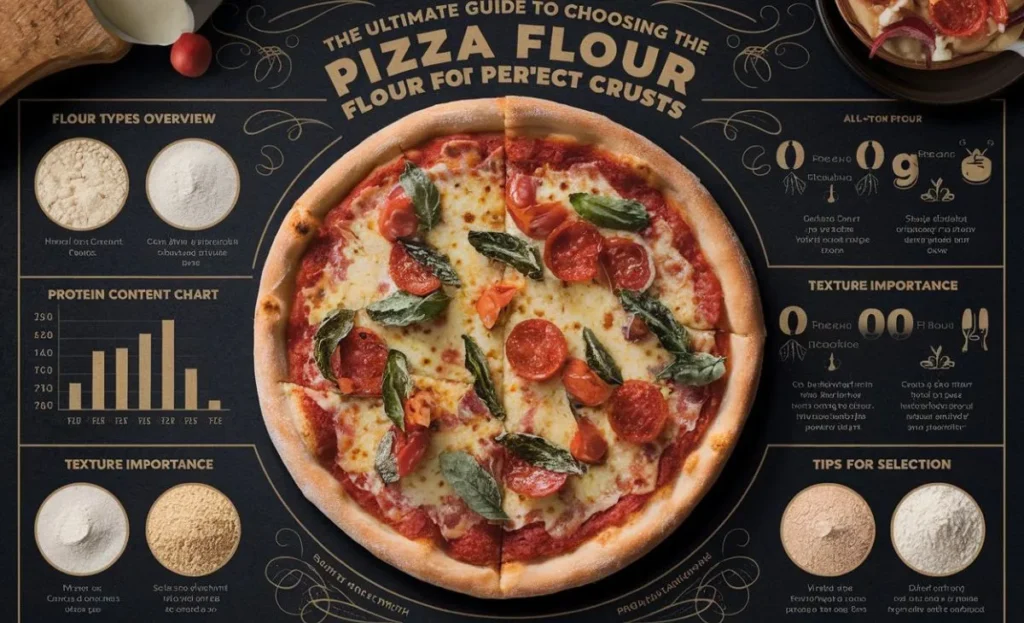
Italian 00 Flour: The Gold Standard
Italian 00 flour is often considered the gold standard for pizza making. Its name comes from the milling process, where the flour is finely ground and classified based on texture. This flour typically has a protein content ranging from 11% to 13%, making it perfect for developing gluten while still producing a soft and elastic dough. The fine texture allows for excellent hydration, resulting in a light and airy crust that many pizza enthusiasts crave.
Other Regional Flours to Consider
While Italian 00 flour is a favorite, several other regional flours can elevate your pizza game. For instance, bread flour, often found in American recipes, has a higher protein content (around 12-14%) and can yield a chewier crust. Similarly, whole wheat flour adds a nutty flavor and increased nutrition, although it may require adjustments in hydration due to its higher fiber content.
Step-by-Step Cooking Instructions for Pizza Dough with Italian 00 Flour
Ingredients:
- 4 cups Italian 00 flour
- 1 ½ cups warm water (110°F or 43°C)
- 2 ¼ teaspoons active dry yeast (1 packet)
- 2 tablespoons olive oil
- 1 teaspoon sugar
- 2 teaspoons salt
Step-by-Step Instructions:
- Activate the Yeast: In a small bowl, combine warm water and sugar. Sprinkle the yeast on top and let it sit for 5-10 minutes until it becomes frothy.
- Mix Ingredients: In a large mixing bowl, combine the Italian 00 flour and salt. Make a well in the center, then add the activated yeast mixture and olive oil.
- Knead the Dough: Stir the ingredients until a rough dough forms. Transfer it to a floured surface and knead for about 8-10 minutes until smooth and elastic. This step is vital for developing the dough’s gluten structure.
- First Rise: Place the dough in a lightly greased bowl, cover it with a clean cloth, and let it rise in a warm place for about 1 hour or until doubled in size.
- Shape and Bake: Preheat your oven to 475°F (245°C). Once the dough has risen, punch it down, shape it into a pizza, and add your favorite toppings. Bake for 12-15 minutes, or until the crust is golden and crispy.
Conclusion
In summary, understanding regional flours like Italian 00 flour and others expands your options for creating the perfect pizza crust. Each flour offers unique characteristics that can enhance your dough’s flavor, texture, and overall quality. By experimenting with these flours and following the step-by-step instructions provided, you’ll be well on your way to crafting pizzas that reflect your culinary preferences and impress your friends and family. So, gather your ingredients and enjoy the delicious journey of pizza-making!
Tips for Selecting the Right Pizza Flour for Your Recipe
Choosing the right pizza flour is crucial for crafting the perfect crust. With so many options available, it can be overwhelming to decide which flour best suits your recipe and personal preferences. Understanding the characteristics of different types of pizza flour, such as protein content, texture, and absorption rates, will help you make an informed choice. In this section, we’ll explore essential tips for selecting the right pizza flour, ensuring your homemade pizza crust turns out delicious every time.

Tips for Selecting Pizza Flour
- Consider the Type of Pizza: Different styles of pizza require different types of flour. For example, if you’re aiming for a classic Neapolitan pizza, Italian 00 flour is ideal due to its fine texture and lower gluten content. On the other hand, if you’re making a New York-style pizza, a higher-protein bread flour will give you the chewy crust you desire.
- Look for Protein Content: The protein content in pizza flour typically ranges from 8% to 14%. Higher protein flours create more gluten, resulting in chewier crusts. If you prefer a lighter, crispier crust, opt for a lower protein flour. Always check the packaging for the protein percentage to choose wisely.
- Assess Flour Texture: The texture of pizza flour affects the dough’s hydration and handling. Finer flours, like Italian 00 flour, absorb water more effectively and yield a softer dough. Coarser flours may require additional water or adjustments to your recipe.
- Experiment with Blends: Don’t hesitate to experiment with different flours. Blending all-purpose flour with specialty flours, like whole wheat or semolina, can add unique flavors and textures to your crust. This flexibility allows you to customize your pizza to match your preferences.
Step-by-Step Cooking Instructions for Pizza Dough
Ingredients:
- 4 cups of your chosen pizza flour (such as Italian 00, bread flour, or a blend)
- 1 ½ cups warm water (110°F or 43°C)
- 2 ¼ teaspoons active dry yeast (1 packet)
- 2 tablespoons olive oil
- 1 teaspoon sugar
- 2 teaspoons salt
Step-by-Step Instructions:
- Activate the Yeast: In a small bowl, mix warm water and sugar. Sprinkle the yeast on top and let it sit for 5-10 minutes until it becomes frothy.
- Combine Ingredients: In a large mixing bowl, combine your chosen pizza flour and salt. Make a well in the center, then pour in the activated yeast mixture and olive oil.
- Knead the Dough: Stir the mixture until a rough dough forms. Transfer it to a floured surface and knead for about 8-10 minutes, ensuring the dough is smooth and elastic. This step is vital for gluten development, giving your crust its structure.
- First Rise: Place the dough in a lightly greased bowl and cover it with a clean cloth. Allow it to rise in a warm place for about 1 hour, or until it doubles in size.
- Shape and Bake: Preheat your oven to 475°F (245°C). Once the dough has risen, punch it down and shape it into a pizza. Add your favorite toppings and bake for 12-15 minutes or until the crust is golden brown.
Conclusion
In conclusion, selecting the right pizza flour is fundamental to creating a perfect crust. By considering the type of pizza, protein content, flour texture, and experimenting with blends, you can elevate your homemade pizza to new heights. Armed with these tips and the step-by-step instructions, you’re ready to embark on your pizza-making journey, crafting delicious crusts that will impress everyone at your table. So, gather your ingredients and enjoy the art of pizza-making!
Conclusion: Achieving the Perfect Pizza Crust
In conclusion, achieving the perfect pizza crust hinges on selecting the right pizza flour for your specific recipe and preferences. With various flour options available, understanding their unique characteristics will significantly impact the final result. From the fine texture of Italian 00 flour to the chewy consistency of bread flour, each type contributes to the overall quality of your pizza. By making informed choices, you can elevate your homemade pizzas to restaurant-quality delights.
Moreover, considering factors such as gluten content and protein levels is essential for creating the desired texture. High-protein flours yield chewier crusts, while lower-protein options create lighter, crispier results. Therefore, identifying the texture you want is crucial. Additionally, experimenting with different blends can lead to exciting flavors and textures, allowing you to customize your pizzas to suit your tastes.
Furthermore, following proper techniques during the dough preparation process enhances your chances of success. Proper kneading develops gluten, which gives your crust structure. Allowing the dough to rise adequately contributes to its texture and flavor. By incorporating these steps into your pizza-making routine, you can achieve a consistent and satisfying crust every time.
Ultimately, the journey to achieving the perfect pizza crust is both an art and a science. By focusing on your choice of pizza flour, understanding its properties, and applying effective techniques, you will create delicious pizzas that impress family and friends. So, roll up your sleeves, gather your ingredients, and enjoy the rewarding experience of making your own perfect pizza crust at home!
Easy and Delicious Dip Recipes for Parties: Perfect for Any Occasion



